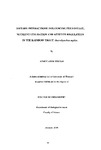DIETARY INTERACTIONS INFLUENCING FEED INTAKE, NUTRIENT UTILISATION AND APPETITE REGULATION IN THE RAINBOW TROUT, Oncorhynchus mykiss
| dc.contributor.author | TEKINAY, AHMET ADEM | |
| dc.contributor.other | School of Biological and Marine Sciences | en_US |
| dc.date.accessioned | 2013-10-02T13:00:36Z | |
| dc.date.available | 2013-10-02T13:00:36Z | |
| dc.date.issued | 1999 | |
| dc.identifier | NOT AVAILABLE | en_US |
| dc.identifier.uri | http://hdl.handle.net/10026.1/1974 | |
| dc.description.abstract |
Dietary factors are one of the most significant considerations in the regulation of appetite in fish since dietary nutrient and energy concentration modulate feed intake in the short and longer term. These interactions may also be important from a commercial aspect, since the objective of aquaculture is to obtain maximum growth, feed efficiency and consumer acceptance of the product. This thesis addresses the major dietary components which are likely to influence appetite in rainbow trout. These include dietary lipid level, carbohydrate content and degree of complexity as well as energy density and protein/energy ratio. Experimental data is presented which examines the influence of such factors on reed intake, growth performance, nutrient utilisation, gastric evacuation rate, return of appetite and changes with respect to the postprandial level of circulating plasma metabolites. It is proposed that rainbow trout have the capacity to regulate feed intake within specific constraints. On the other hand, trout become obese when offered high oil diets and fail to control feed intake in the short term, possibly due to the palatability of lipids. Regulation may also appear at a metabolic level following accumulation of lipids in adipose tissue. Gastric evacuation rate was probably the main factor in the short term influencing feed intake. This was irrespective of carbohydrate complexity or level in the diet. However, simple sugars might suppress the appetite of trout in the longer term. The biochemical status of liver via plasma glucose concentration may play a more important role compared to gastric fullness in the long- term regulation of appetite. It was postulated that X-radiography was a paramount technique for the quantification of sequential meals and return of appetite measurements in these investigations. The above parameters and their interactions were studied in relation to the physiological control of feed intake in order to develop a more defined model for such processes and to improve the optimum feeding regimes for rainbow trout under intensive production conditions. This is discussed within the wider concept of fish nutrition, and the implications for future research in this area are stated. | en_US |
| dc.language.iso | en | en_US |
| dc.publisher | University of Plymouth | en_US |
| dc.title | DIETARY INTERACTIONS INFLUENCING FEED INTAKE, NUTRIENT UTILISATION AND APPETITE REGULATION IN THE RAINBOW TROUT, Oncorhynchus mykiss | en_US |
| dc.type | Thesis | |
| plymouth.version | Full version | en_US |
| dc.identifier.doi | http://dx.doi.org/10.24382/3332 | |
| dc.identifier.doi | http://dx.doi.org/10.24382/3332 |
Files in this item
This item appears in the following Collection(s)
-
01 Research Theses Main Collection
Research Theses Main


